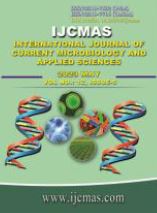


 National Academy of Agricultural Sciences (NAAS)
National Academy of Agricultural Sciences (NAAS)

|
PRINT ISSN : 2319-7692
Online ISSN : 2319-7706 Issues : 12 per year Publisher : Excellent Publishers Email : editorijcmas@gmail.com / submit@ijcmas.com Editor-in-chief: Dr.M.Prakash Index Copernicus ICV 2018: 95.39 NAAS RATING 2020: 5.38 |
India ranks among the top vegetable producers, yet rural households frequently struggle with malnutrition, particularly when it comes to vitamin deficits. The lack of knowledge, illiteracy, and access to sufficient quantities of fruits and vegetables could be the contributing factors, besides family purchasing power is also very low. According to the Recommended Dietary Allowances, a person should consume 300 g of vegetables each day, including roots and tubers, green leafy vegetables, and other vegetables. Taking into account the widespread malnutrition, particularly the lack of certain micronutrients, and the scarcity of vegetables, this study was carried out to assess the extent of nutrition security among thirty selected nuclear families, after setting up nutrition gardens in their households, along with a control garden in the College campus. The contribution of iron from vegetables cultivated in control garden was higher than in household garden. Organically set up nutrition gardens in the study could not meet the recommended dietary, hence it was realized that there is a need to scale up the area of cultivation and an increase the number of crops, which are disease resistant. The common land resources of the community could be utilized. Continuous and vigilant monitoring of the gardens would improve the productivity.
 |
 |
 |
 |
 |